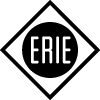
Back Erie Railroad German Erie Railroad French Erie Railroad Hungarian Erie Railroad Italian エリー鉄道 Japanese 이리 철도 Korean Erie Railroad NB 伊利铁路 Chinese
This article includes a list of general references, but it lacks sufficient corresponding inline citations. (March 2024) |
 | |
 A map of Erie Railroad's rail lines | |
| Overview | |
|---|---|
| Headquarters | New York City, U.S. (1832–1931) Cleveland, Ohio, U.S. (1931–60) |
| Reporting mark | ERIE |
| Locale | New Jersey Pennsylvania New York Ohio Indiana Illinois |
| Founder | Eleazar Lord |
| Dates of operation | 1832–1960 |
| Successor | Erie Lackawanna Railway |
| Technical | |
| Track gauge | 4 ft 8+1⁄2 in (1,435 mm) standard gauge |
| Previous gauge | 6 ft (1,829 mm) gauge |
| Length | 2,316 miles (3,727 kilometers) |
The Erie Railroad (reporting mark ERIE) was a railroad that operated in the Northeastern United States, originally connecting Pavonia Terminal in Jersey City, New Jersey, with Lake Erie at Dunkirk, New York. The railroad expanded west to Chicago following its 1865 merger with the former Atlantic and Great Western Railroad, also known as the New York, Pennsylvania and Ohio Railroad (NYPANO RR).
The mainline route of the Erie Railroad proved influential in the development and economic growth of the Southern Tier of New York state, including the cities of Binghamton, Elmira, and Hornell. The Erie Railroad repair shops were located in Hornell and was Hornell's largest employer. Hornell was also where Erie's mainline split into two routes with one proceeding northwest to Buffalo and the other west to Chicago.
On October 17, 1960, Erie Railroad merged with its former rival, Delaware, Lackawanna and Western Railroad, to form the Erie Lackawanna Railway. The Hornell repair shops were closed in 1976, when Conrail took over, and repair operations moved to the Lackawanna's facility in Scranton, Pennsylvania. Some of the former Erie line between Hornell and Binghamton was damaged in 1972 by Hurricane Agnes, but the damage was quickly repaired and today this line is a key link in the Norfolk Southern Railway's Southern Tier mainline. What was left of the Erie Lackawanna became part of Conrail in 1976.[1] In 1983, remnants of the Erie Railroad became part of New Jersey Transit rail operations, including parts of its Main Line, and most of the surviving Erie Railroad routes are now operated by the Norfolk Southern Railway.